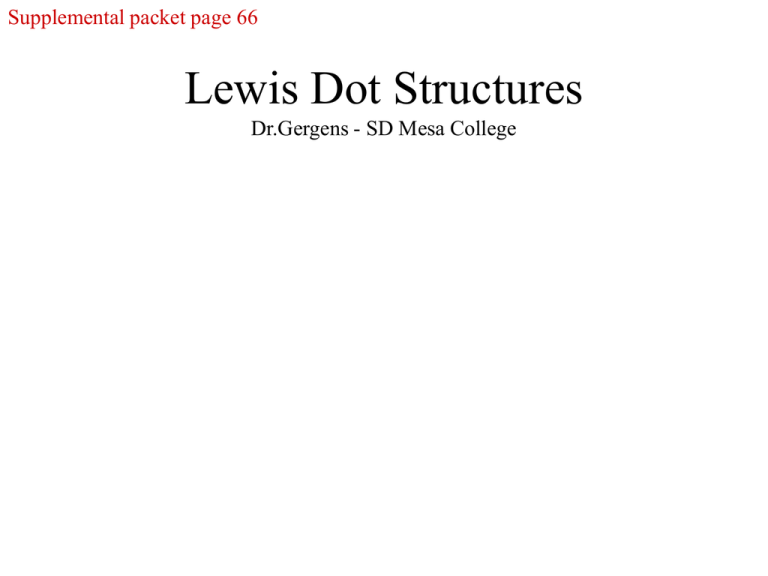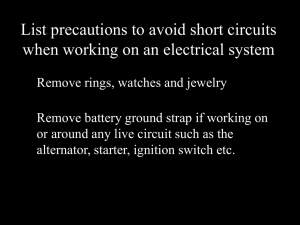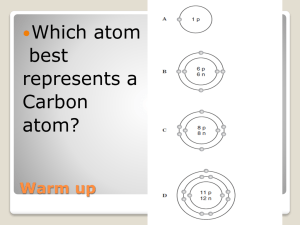Lewis Dot Structures Dr.Gergens
advertisement

Supplemental packet page 66 Lewis Dot Structures Dr.Gergens - SD Mesa College Things to keep in mind when drawing Lewis structure 1. Always count valence electrons 2. Know the preferred number of bonds to these elements CNOFH 4 3 211 3. N O , these elements may have (2) (1) a variable number of bonds (4) (3) 4. If the substance has hydrogen list first in its formula: a. the substance is characterized as an acid b. the H is bound to oxygen in the substance’s structure 5. F O N Cl Br I S C H for determining bond polarity F O N Cl Br I S C H for determining bond polarity between nonmetal atoms Large difference in electronegativity between H—F most polar bond between C—F very polar bond F O N Cl Br I S C H Little difference in electronegativity Less polar Between identical atoms, C-C, F-F bonding is nonpolar 1. Calculate 2. Assemble 3. Connect the other atoms to the central Each line represents a single bond made shared between two atoms. 4. Give the outer paired electrons. 5. the total number the bonding most of valence framework. atoms, EXCEPT for hydrogen, sets of 1C • 4 4H•1 = 4 = 4 + VE = 8 Add missing 7. Apply the octet rule to check to see that each atom has eight electrons surrounding it. 9. three Count valence electrons in your provisional structure. valence electrons calculate in step 1 are present. electrons group # by drawing a single line. up of two electrons being 6. 8. CH4 electrons. to the central atom. Share neighboring electrons by moving electrons to satisfy the octet about each atom. Place a bracket around ions, followed by ion charge. See if all H H C H H 1. Calculate the total number 2. Assemble 3. Connect the other atoms to the central Each line represents a single bond made shared between two atoms. the bonding most of valence NH4 electrons. framework. 4. Give the outer paired electrons. 5. Count valence electrons in your provisional structure. valence electrons calculate in step 1 are present. EXCEPT for hydrogen, 6. Add missing 7. Apply the octet rule to check to see that each atom has eight electrons surrounding it. 8. Share neighboring electrons by moving electrons to satisfy the octet about each atom. 9. electrons atoms, by drawing a single line. up of two electrons being to the central atom. Place a bracket around ions, followed by ion charge. three sets of group # 1N • 5 = 5 4H•1 = 4 + 1 = -1 VE = 8 See if all H H N H HH 1. Calculate the total number 2. Assemble 3. Connect the other atoms to the central Each line represents a single bond made shared between two atoms. the bonding most of valence electrons. BH3 framework. 4. Give the outer paired electrons. 5. Count valence electrons in your provisional structure. valence electrons calculate in step 1 are present. 6. Add missing 7. Apply the octet rule to check to see that each atom has eight electrons surrounding it. electrons atoms, by drawing a single line. up of two electrons being EXCEPT for hydrogen, to the central three sets of group # 1B • 3 4H•1 = 4 + 1 = 1 VE = 8 See if all H atom. H 8. 9. Share neighboring electrons by moving electrons to satisfy the octet about each atom. Place a bracket around ions, followed by ion charge. = 3 B H H 1. Calculate 2. Assemble 3. Connect the other atoms to the central Each line represents a single bond made shared between two atoms. Give the outer paired electrons. most electrons. CO2 framework. atoms, by drawing a single line. up of two electrons being EXCEPT for hydrogen, three Count valence electrons in your provisional structure. valence electrons calculate in step 1 are present. 6. Add missing to the central atom. of = 4 2O•6 = 12 + Apply the octet rule to check to see that each atom has eight electrons surrounding it. 8. Share neighboring electrons by moving electrons to satisfy the octet about each atom. Place a bracket around ions, followed by ion charge. See if all •• OO O •• •• •• •• 7. 9. sets 1C • 4 VE = 16 5. electrons group # C C •• •• •• OOO •• •• •• •• •• •• the bonding of valence •• •• •• 4. the total number Calculate the total number 2. Assemble 3. Connect the other atoms to the central Each line represents a single bond made shared between two atoms. NO2 framework. 5. Count valence electrons in your provisional structure. valence electrons calculate in step 1 are present. 6. Add missing 7. Apply the octet rule to check to see that each atom has eight electrons surrounding it. 8. Share neighboring electrons by moving electrons to satisfy the octet about each atom. to the central atom. Place a bracket around ions, followed by ion charge. three sets of = 5 2 O • 6 = 12 – + 1e = 1 VE = 18 See if all •• •• EXCEPT for hydrogen, 1N • 5 •• •• O O O OO •• •• •• •• •• •• •• •• Give the outer paired electrons. electrons atoms, group # by drawing a single line. up of two electrons being 4. 9. most electrons. •• •• the bonding of valence •• •• •• •• •• •• •• O N O NN O N •• OO •• •• •• •• •• •• •• •• •• 1. valence shell electron pair repulsion VSEPR = ________ ________ ________ ________ ________ Deter mi ne the angl es between bonds, name the g eometry about the central atom and g ive the its hybridizati on. Ideal bonding for carbon is Four bonds to carbon - Four bonding modes Ide al Ge om e tr ie s 109.5 109.5 H C H bond angles g eometr ic name H H 120C 120 120 H 120 H 109.5 H109.5 H tetrahedral C 180 H trigonal planar C C H linear O 180 C O linear Ideal bonding angles for carbon Non-Ide al Ge om e tr ie s : : : bond ang les g eometr ic name H N H 107.5 H107.5 pyramidal or trigonal pyramid N H q<120 bent : O H 104.5 H g eometr ic name bent O : : N N H : bond ang les : N C Bond angles for non-ideal geometries are less than an ideal angle in ideal for C. H This is because an electron pair 1) occupies a lot of space & 2) is held close to nucleus of central atom H supplemental HO 70 1. Calculate 2. Assemble 3. Connect the other atoms to the central Each line represents a single bond made shared between two atoms. 4. Give the outer paired electrons. 5. Count valence electrons in your provisional structure. valence electrons calculate in step 1 are present. 6. Add missing 7. Apply the octet rule to check to see that each atom has eight electrons surrounding it. 8. Share neighboring electrons by moving electrons to satisfy the octet about each atom. 9. the total number the bonding most electrons of valence electrons. framework. atoms, by drawing a single line. up of two electrons being EXCEPT for hydrogen, to the central atom. Place a bracket around ions, followed by ion charge. three sets of See if all






